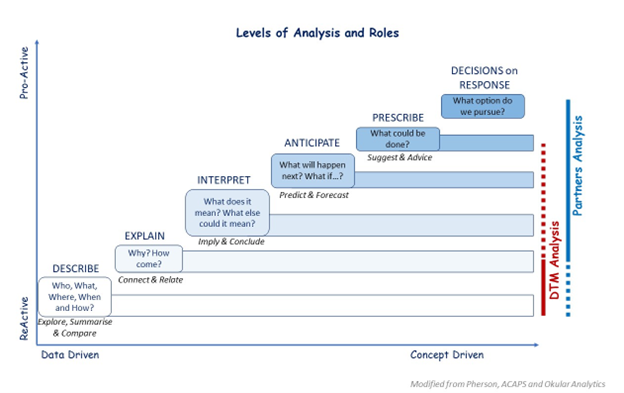Different roles and responsibilities for different levels of analysis
Different levels of analysis are the responsibility of different actors: DTM may be able to do some descriptive analysis of sectoral data, however the responsibility for using DTM and other data to conduct explanatory analysis, interpretation and prescriptive analysis to develop response options remains with the partners.
The specific details of who will conduct what part of descriptive analysis must be agreed upon at country level, before the data is collected.
If neither DTM nor partner have set aside resources to analyse specific datasets, collecting such datasets has no purpose and should be reconsidered.
Analysis generally refers to the organized process of transforming raw data into actionable insights, for better decision making.
Most forms of analysis can be described as levels, where one builds on another, each increasing the understanding of the findings and revealing progressively what the data means, what may happen next and what could or should be done about it.
Six levels are commonly used for data analysis, represented in the following diagram that includes also responsibilities of DTM and Partners at each level of analysis for sectoral data.

Each analytical level entails different activities and require different combinations of competencies AND interaction with experts:
- Exploratory analysis: The analysis team assess geographical coverage, available and unavailable data, correct errors and prepare for further analysis. Potential “stories” that will need further investigation are identified; DTM may implement this level of analysis on DTM sectoral data.
- Descriptive analysis: The analysis team summarize and consolidate key variables and observations and prepare results using pre-identified analysis plan. Main patterns, trends, anomalies and outliers are identified; DTM may implement this level of analysis on DTM sectoral data (according to Analysis Plan). At this stage, the data will also be shared with subject-matter experts (e.g., Clusters) for additional ad-hoc descriptive analyses that may be useful to individual sectors, and for further analysis (see below).
- Explanatory analysis: The analysis team, consisting of subject-matter and context/cultural experts, identifies main underlying mechanisms/processes/factors that contribute to current gaps; DTM does not implement this level of analysis on sectoral data, while it may do so for population movements and trends.
- Interpretive analysis: The expert analysis team discusses and establishes critical gaps, sets priority geographical areas and affected groups and assesses uncertainty and information gaps; DTM does not implement this level of analysis on sectoral data.
- Anticipatory analysis: Based on risk analysis and possible scenario, the analysis team, in consultation with experts, discuss and establish future potential gaps and refine the list of priority geographical areas or affected groups; DTM does not implement this level of analysis on sectoral data.
- Prescriptive analysis: The analysis team, in consultation with experts, discuss and agree on a strategy and objectives to change or prevent humanitarian outcomes and recommend a set of appropriate and proportionate response options (this process is also called response analysis). They define the activities and resources required to achieve the objectives (Response planning). DTM does not implement this level of analysis.
DTM shares data with partners, and can do some descriptive analysis for sectoral data, as detailed in the Data Analysis Plan. Interpretation, explanation and higher levels of analysis are the responsibility of Partners, that may analyse DTM data together with additional sources.
PLANNING for ANALYSIS
- From the planning phase, It is crucial that DTM and Partners agree on whether DTM will only share data or also some type of descriptive analysis, as well as the modalities (public/restricted) and frequency of that sharing for each dataset.
- During the planning phase, it is also important that DTM and partners agree on how results should be aggregated and analysed by DTM (what descriptive analysis the cluster wants should be included in the DTM Data Analysis Plan.
- Field experience consistently highlights the effectiveness of targeted presentations of results by DTM to Inter-Cluster/Sector or Sectoral/Cluster Groups. This is useful as few people have the time to read whole reports and presentations of results can be very effective in supporting accurate interpretation by subject-matter experts, cultural/context experts and decision makers (e.g., in a cluster meeting).
- In some cases, if planned accordingly, DTM data can be analysed to provide sectoral severity and priority information (see
- (see UNICEF Guide _Sector severity and priority IDP locations with DTM data).
Available Tools
- DTM Data Analysis Plan (template), in: https://dtm.iom.int/dtm-partners-toolkit/analysis
- Options for Analysis for DTM and Partners, in: https://dtm.iom.int/dtm-partners-toolkit/analysis
- Roles in Analysis: in Pocket Guide to the shared approach, pages 20 and 21, in: https://dtm.iom.int/dtm-partners-toolkit/predictable-approach
- DTM Data in Partners analysis and decision making, in: https://dtm.iom.int/dtm-partners-toolkit/analysis
- UNICEF Guide _Sector severity and priority IDP locations with DTM data, and the narrated briefing that explains it, in: https://dtm.iom.int/dtm-partners-toolkit/analysis
